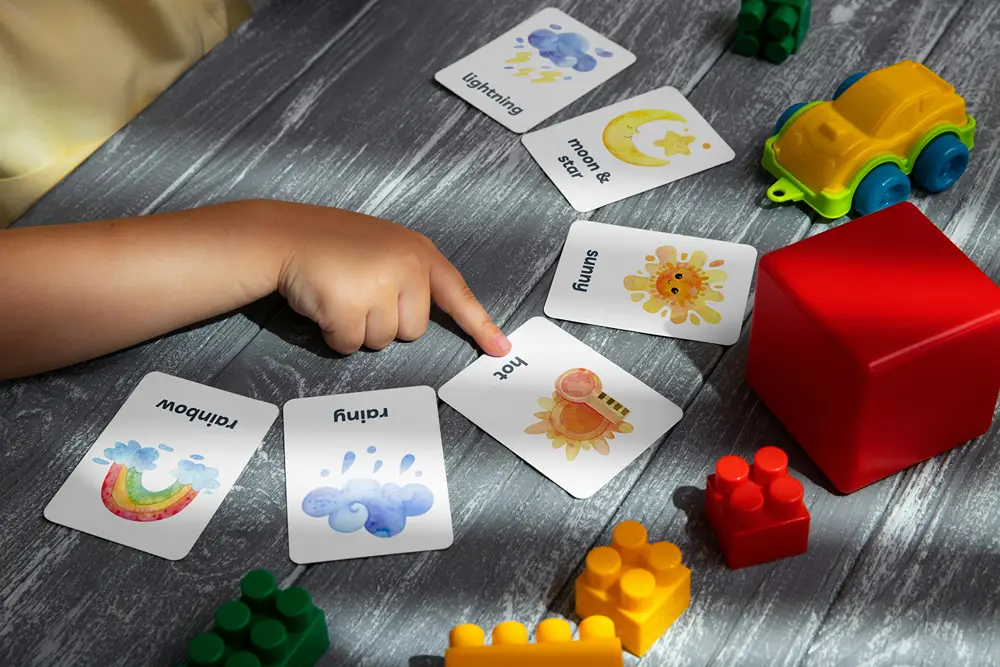How to Make Flashcard Games Your Kids Will Actually Love [Teacher-Tested Tips]
Traditional flashcard games often end with frustrated kids and discouraged parents. Despite good intentions, these study tools frequently collect dust or become dreaded objects of learning battles. However, flashcard games don’t have to be boring or ineffective. In fact, when designed thoughtfully, they can transform into powerful learning tools that children actually look forward to using.
Fortunately, there are proven strategies to make flashcards engaging and fun, regardless of your child’s age or learning style. Digital cards can be easily used for online educational games and converted by PNG to JPG converter online for multi-platform usage.
This guide shares teacher-tested methods to create flashcard activities your kids will genuinely enjoy. From movement-based games to digital alternatives, you’ll discover practical ways to customize these learning tools to match your child’s interests and keep them coming back for more.
Age-Appropriate Flashcard Games That Work
Tailoring flashcard games to your child’s developmental stage transforms them from dreaded drills into exciting learning opportunities. The key is matching the activity to your child’s age-specific interests and abilities, consequently creating an experience they’ll want to repeat.
Preschoolers (3-5 years): Simple matching and movement games
Young children learn best when movement and play drive the experience. For preschoolers, flashcard games should be brief, physical, and filled with positive reinforcement.
Flashcard Jump works wonderfully with this age group. Simply lay cards on the floor and have your child jump from one to another, identifying each picture or letter as they land. This combines gross motor skills with visual recognition, making learning feel like playtime.

Flashlight Hunt adds excitement to basic identification. Hide flashcards around a darkened room and give your child a flashlight to “discover” them. As they find each card, they identify what’s on it before hunting for the next one.
Simple Matching games are particularly effective for this age group. One parent noted, “We use flashcards for building numbers in first grade along with other math fun. We had a set where on one side it would say ‘6’, and on the back it had ways to make six, and my son would build them with beans or ladybugs.”
Early elementary (6-8 years): Competitive and collection-based games
As children develop, incorporating gentle competition and collection mechanics keeps flashcard games engaging.
Flashcard Fishing appeals to this age group’s love of imaginative play. Attach paper clips to your flashcards, provide a fishing pole with a magnet tied to the end, and have children “fish” for cards. Each caught card requires identifying the content before it counts toward their collection.
Tic-Tac-Toe with flashcards introduces strategic thinking. Children take turns picking a card and identifying it correctly to place their X or O on the game board. This familiar game structure adds purpose to flashcard practice.
Elementary students respond well to timed challenges. One effective approach uses electronic flashcards with multiple difficulty levels and both timed and untimed modes, providing positive feedback—both visual and auditory—when children succeed.

Older elementary (9-12 years): Strategy and speed challenges
Older children thrive on complexity and measurable achievement in their learning activities.
Memory Match games can be adapted for this age group by making the matches less obvious. Instead of identical pairs, create matches between related concepts (like a number matched with fingers representing that number) or between problems and solutions.
Flashcard Spelling Bee challenges older students to spell out words corresponding to images on flashcards. This multi-step processing reinforces both visual recognition and spelling skills simultaneously.
For math practice, speed challenges with progressive difficulty levels help children build both accuracy and confidence. One parent shared, “We do ten math facts flash cards every day. He gets an M&M for each one correct, so he’s super motivated.”
Flashcard Relay/Racing games work exceptionally well for this age group. Lay the flashcards across the room in a line. Call out a specific card that your child must find, solve, and then run back with. This combines physical activity with critical thinking under pressure.
The most successful flashcard systems for older elementary students offer multiple levels of difficulty plus both individual and group play options. This adaptability keeps the challenge fresh as skills develop, preventing the boredom that typically derails traditional flashcard use.
Incorporating Movement to Boost Engagement
Physical activity creates a powerful connection between body and mind, making flashcard learning significantly more effective. Research shows that combining movement with study significantly improves information retention across all age groups. Below, you’ll discover three proven approaches to incorporate movement into flashcard games that kids genuinely enjoy.
Jump and learn activities
Jump-based flashcard games are perfect for high-energy children who struggle with sitting still. Initially, arrange flashcards in a pattern on the floor with space between each card. Children jump from card to card, identifying each one they land on or next to.
Flashcard Jump provides excellent gross motor practice alongside learning. One educator describes this as “a fast, fun game of toss, catch, and pass” that keeps children physically engaged while processing information.
Another effective variation is Climb Up the Stairs, where you place one flashcard on each step. As children climb each step, they identify the letter, number, or word. This creates a physical metaphor for progress that children find incredibly motivating.
Third-party reviews confirm the effectiveness of these approaches: “Engage your action-loving toddler with Jump & Learn cards! This multi-sensory set of flashcards encourages active focused learning, helping your child explore letters, numbers, shapes, and colors as they hop, skip, and jump!”
Customizing Flashcards to Your Child’s Interests
The secret to truly effective flashcard games lies in personalization. When cards reflect your child’s unique interests and experiences, they transform from mere study tools into engaging learning companions. By tailoring flashcards to what excites your child, you’ll naturally increase both their enjoyment and retention.

Connecting flashcards to real-life experiences
Personal examples are extraordinarily powerful memory tools. When flashcards incorporate real-world connections from your child’s life, retention dramatically improves. Use humor, narratives, and personal examples to make abstract concepts concrete and memorable.
As one educator noted, a student preparing for medical school found that incorporating real-life case studies into her flashcards made the material more relatable and easier to remember. For younger children, try creating visual associations between flashcards and objects in your home, or relate card content to recent family experiences.
Letting kids create their own cards
Perhaps the most powerful customization strategy involves letting children design their own flashcards. This creative process offers multiple benefits:
- Summarizing information on cards checks understanding and often naturally commits content to memory
- Adding colorful drawings, stickers, or decorative borders creates emotional investment
- The creation process itself becomes a valuable learning activity
As one resource emphasizes, “Let your kids get creative by making their own flashcards. Let them come up with something they want to learn and help them reach that goal.” Essentially, this collaborative approach transforms passive review into active learning while giving children ownership of their educational journey.
Conclusion
Flashcards remain powerful learning tools when thoughtfully adapted to match children’s needs and interests. Rather than sticking to traditional drilling methods, successful flashcard games combine movement, technology, and personalization to create genuinely enjoyable learning experiences.
Studies consistently show that children learn best when activities align with their developmental stage and personal interests. Whether through scavenger hunts for active learners, digital games for tech-savvy kids, or custom-made cards featuring favorite characters, these adaptations transform simple study tools into engaging educational experiences.
Remember that effective flashcard learning happens gradually. Start with a few cards in short, fun sessions. Watch how your child responds and adjust accordingly. Most importantly, celebrate small wins along the way – because when children actually enjoy using flashcards, lasting learning naturally follows.







